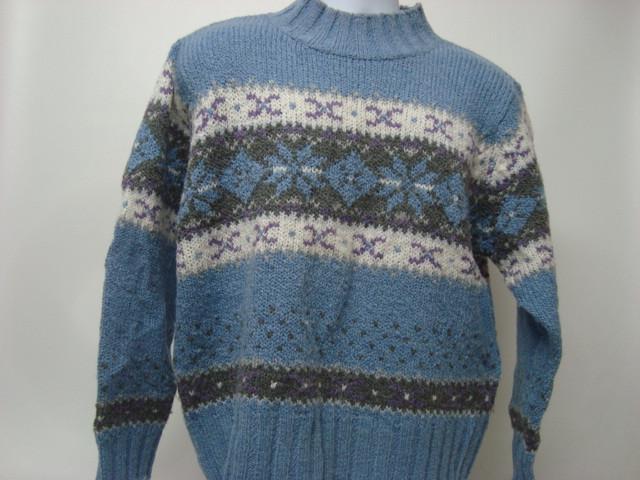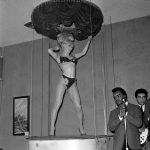The Sweater
Make it with quality. Make it with pride. Make it last.
It was cold this morning here in Tampa, Florida.
A chilly 54 degrees.
For people up North that seems warm, but for us Floridians, when it drops into the 50s we’re breaking out the parkas and the sled dogs. I left the Tommy Bahama shorts in the closet and grabbed a pair of blue jeans this morning. Even put on socks for the first time this year.
So when I saw my son later in the day and he was wearing a thick blue cardigan sweater, I wasn’t surprised.
“Did you know that was my father’s sweater?”
“Yes, you tell me that every time I wear it.”
“I can remember him wearing that sweater when I was a freshman in high school.”
“You tell me that every time, too.”
It’s true, the part about it being my father’s sweater. It’s a pale blue sweater with gray and black diamond shapes across the chest. It’s open in the front, no buttons, and has huge wide collars. It’s as vintage as vintage can get. I can still see my father wearing it while sitting in his Lazyboy recliner watching the Dallas Cowboys on TV. That was 50 years ago, so the sweater has been around for more than a half century.
When my father passed, I took over ownership of the sweater. At some point it disappeared from my closet and I started seeing my son wearing it. I have no doubt that when he has his first child the sweater will eventually end up in that child’s closet.
That sweater has been worn constantly over the last 50 years and has been extensively worn in Louisiana, Texas, Florida, California, and New York, and has even made an appearance in London, Amsterdam and Frankfurt. The sweater has been around the world and has been on this planet longer than most of the people who are now alive on this planet, and yet, it looks like it just came off the rack.
No rips. No fading. No stretched fabric. No loose strings.
It’s solid.
What are the chances you could buy a sweater today, or any piece of clothing, and wear it for 50 years and have it hold up? Never happen.
Because the things we make today—even the things we do today—are not made or done with the same attention to quality as in the past. And the things we make and the things we do today are not made with the same pride as in the past. It’s all short term. No long term. No planning for the future. No respecting the future.
At least once a month I throw away a piece of clothing because it’s fallen apart. A pair of underwear here, a pair of shorts there. Stitches come undone, seams rip, colors fade. This from clothing that is only a year or two old.
My wife and I are on our fifth Keurig coffee machine in less than four years. The first few times that we replaced the machine, we complained to each other. Not any more. Now my wife just says, “The Keurig’s dead. We need another one.” We just expect it to fall apart.
Everything you buy today has a warranty. Usually a one- or two-year warranty. “Why,” I want to ask the salesperson, “are you selling me this piece of crap if you don’t expect it to be working a year from now?” If only I had the money back from all the internet routers and phone systems and power tools and car accessories and cooking appliances and laptops and outdoor grills and suitcases I have bought over the years only to toss them out after a few years because they stopped working properly. In the meantime, on every episode of the TV show “Pawn Stars” someone is bringing in a mechanical device or a contraption from the late 1900s that still works like a charm.
Things are so temporary today, so flimsy, so disposable. We have even changed our lifestyle to accommodate those temporary things. Now, once a week there is a blue recycle trash can at the end of our driveway filled with the things we make and use just once. Plastic water bottles, cardboard boxes, Diet coke cans. We used to drink water out of a glass, a glass we used every day for years. We used to wash cloth diapers and reuse them. We used to drink pop out of a bottle and then turn that bottle in for a few pennies and they would clean the bottle and refill it with more pop. We used to buy cars and keep them for years. Now we lease cars and get rid of them in three to four years. They’re advertising the iPhone 12 as you’re unwrapping the iPhone 11 you just bought.
In my house today there are china bowls and serving platters and small pieces of furniture and knick-knacks that were in the house I lived in 50 years ago as a teenager. Partly they are there because we all want to keep mementos from our past, but mainly they are there because those items were made so well back then that they are still around today. I would not have a ceramic salad bowl with flowers on it from 1950 in my kitchen cabinet if it wasn’t made with enough quality craftsmanship to withstand 70 years of use. I can’t say the same about anything I might order today off Amazon or buy at Walmart.
In our dining room is a mahogany tea cart that my mother received the year she was married in the 1950s. My wife and I have had that tea cart for 20 years and during that time we have replaced many coffee tables, couches and dining room sets that we bought, all made with some type of mystery wood that could not hold up for more than a half dozen years of use. That tea cart will still be here—at my daughter’s house, most likely—many decades after I’ve left the scene.
I don’t know what’s worse, the fact that everything made today is done with planned obsolescence right around the corner, or the fact that we simply accept it and don’t demand better?
I would guess the latter. Because today it’s all about immediate gratification, not long-lasting satisfaction, in the things we do, the things we say, and the things that we, unfortunately, no longer plan ahead for. It’s not about quality down the line; it’s about quantity right now.
It’s all about a text message rather than talking face to face with a friend over a cup of coffee. It’s all about getting our opinions from a Tweet and not from a reliable source. It’s all about reading a summary of the subject on Wikipedia and not reading the book ourselves, or watching the entire movie. It’s all about destroying the future of the planet and its resources so we can drive our car today or build another subdivision today. And if someone doesn’t agree with you, just Unfriend them. Don’t take the time to hear their side of the story and keep the relationship alive. You’re upset now; later doesn’t matter.
Really, the only things we make today that will last into the future are our children.
And what will be leaving for them? What will they get from us that will last for another 50 years?
Anything of quality?
Anything made with pride?
Even just a pale blue sweater.



























